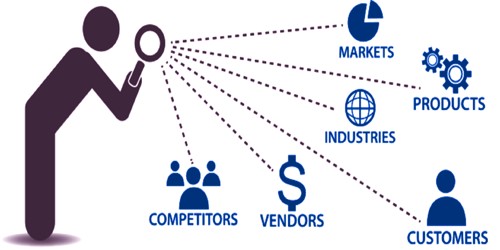A marketing intelligence system is a set of procedures and sources that managers use to obtain everyday information about developments in the marketing environment. The internal records system supplies results data, but the marketing intelligence system supplies happenings data.
Marketing managers collect marketing intelligence in a variety of different ways, such as by reading books, newspapers, and trade publications; talking to customers, suppliers, and distributors; monitoring social media on the Internet, and meeting with other company managers. Before the Internet, sometimes you just had to go out in the field, literally, and watch the competition. This is what oil and gas entrepreneur T. Boone Pickens, Describing how he learned about a rival’s drilling activity, Pickens recalls, “We would have someone who would watch [the rival’s] drilling floor from a half mile away with field glasses. Our competitor didn’t like it but there wasn’t anything they could do about it our spotters would watch the joints and drill pipe. They would count them; each [drill] joint was 30 feet long. By adding up all the joints, you would be able to tally the depth of the well.” Pickens knew that the deeper the well, the more costly it would be for his rival to get the oil or gas up to the surface, and this information provided him with an immediate competitive advantage.
(a) Train and motivate the sales force to spot and report new developments.
The company must “sell” its sales force on their importance as intelligence gatherers. Grace Performance Chemicals, a division of W. R. Grace, supplies materials and chemicals to the construction and packaging industries. Its sales reps were instructed to observe the innovative ways customers used its products in order to suggest possible new products. Some were using Grace waterproofing materials to soundproof their cars and patch boots and tents. Seven new-product ideas emerged, worth millions in sales.
(b) Motivate distributors, retailers, and other intermediaries to pass along important intelligence.
Marketing intermediaries are often closer to the customer and competition and can Offer helpful insights. ConAgra has initiated a study with some of its retailers such as Safeway, Kroger, and Walmart to study how and why people buy its foods. Finding that shoppers who bought their Orville. Redenbacher and Act II brands of popcorn tended to also buy Coke, ConAgra worked with the retailers to develop in-store displays for both products. Combining retailers’ data with its own qualitative insights, ConAgra learned that many mothers switched to time-saving meals and snacks when school started. It launched its “Seasons of Mom” campaign to help grocers adjust to seasonal shifts in household needs.
(c) Hire external experts to collect intelligence.
Many companies hire specialists to gather marketing intelligence.13 Service providers and retailers send mystery shoppers to their stores to assess the cleanliness of facilities, product quality, and the way employees treat customers. Health care facilities’ use of mystery patients has led to improved estimates of wait times, better explanations of medical procedures, and less-stressful programming on the waiting room TV.
(d) Network internally and externally.
The firm can purchase competitors’ products, attend open houses and trade shows, read competitors’ published reports, attend stockholders’ meetings, talk to employees, collect competitors’ ads, consult with suppliers, and look up news stories about competitors.
(e) Set up a customer advisory panel.
Members of advisory panels might include the company’s largest, most outspoken, most sophisticated, or most representative customers. For example, GlaxoSmithKline sponsors an online community devoted to weight loss and says it is learning far more than it could have gleaned from focus groups on topics from packaging its weight loss pill to where to place in-store marketing.
(f) Take advantage of government-related data resources.
The U.S. Census Bureau provides an in-depth look at the population swings, demographic groups, regional migrations, and changing the family structure of the estimated 304,059,724 people in the United States (as of July 1, 2008). Census marketer Nielsen Claritas cross-references census figures ‘with consumer surveys and its own grassroots research for clients such as The Weather Channel, BMW, and Sovereign Bank. Partnering with “list houses” that provide customer phone and address information, Nielsen Claritas can help firms select and purchase mailing lists with specific clusters.
(g) Purchase information from outside research firms and vendors.
Well-known data suppliers include firms such as the A.C. Nielsen Company and Information Resources Inc. They collect information about product sales in a variety of categories and consumer exposure to various media. They also gather consumer-panel data much more cheaply than marketers manage on their own. Biz360 and its online content partners, for example, provide real-time coverage and analysis of news media and consumer opinion information from over 70,000 traditional and social media sources (print, broadcast, Web sites, blogs, and message boards).













